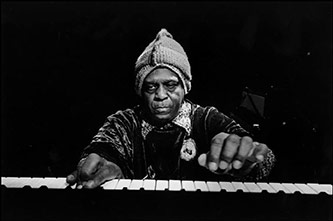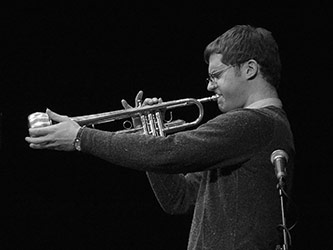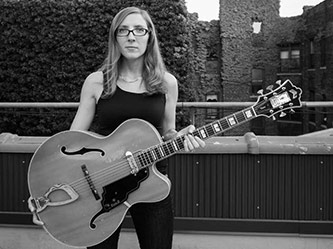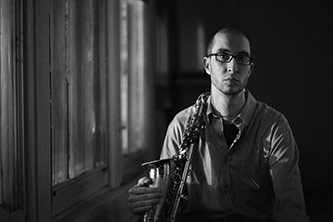American Music Review
Vol. XLV, No. 2, Spring 2016
By Daniel Blake
People have a lot more of the unknown than the known in their minds.
The unknown is great; it’s like the darkness. Nobody made that. It just happens.
Sun Ra11
Following a 2013 performance of a string quartet in which I participated as composer and saxophonist, a colleague told me how he had enjoyed a certain passage that he assumed to be improvised. Although the passage was notated, the comment led me to reflect on the many rehearsals I had held with the quartet, during which we would discuss ideas and improvise together. We were trying to establish a working method that would break out of the conventional composer-performer model, and our hope was that it would be more suitable to the diverse aesthetic we were interested in exploring.2 As for the passage in question, I remember settling on a shorthand notation approximating a mix of bow noise, sliding harmonics, and fast tremolos. By the time of the performance the quartet was entirely familiar with the texture, rendering my notation somewhat redundant.
In fact, the passage represented a particular aesthetic agreement we had forged together. That agreement led us to a hybrid musical structure exemplifying what Robert Morris has called a “compositional space,” which I adopt here to signify a set of aesthetic possibilities that is mutually understood by a group of individuals, and which is worked out in real time.3 These spaces represent “cracks” through which much analytical discourse about contemporary music falls, in part because they are tailored to the specific needs of one particular group or individual. To be clear, this essay is not an attempt to re-litigate the analytical binary of “improvisation versus composition,” but rather to understand the unique practices of particular individuals who take improvisation as a given for their practice. An effort to capture a more complete understanding of compositions that are not formalized as musical scores must involve a better understanding of the musical communities from which these compositions emerged. With this potential gap of understanding in mind, I pursued the question of compositional spaces by speaking directly with musical practitioners living and working in New York City. These improviser-composers come from diverse backgrounds in African American, European, folkloric, and electronic music, and are people with whom I maintain some degree of professional affiliation as a performer.
The notion of hybridity refers to musical practices that occupy several idioms simultaneously, and not to music that self-consciously adheres to a single idiom like jazz improvisation using song forms. A central challenge in performing musical hybridity is how to create the conditions for a satisfying musical experience in the absence of either a formalized score or an idiomatic lineage to codify musical expectations. Given the extraordinary diversity of alternative approaches outside of strict idiomatic improvisation available to contemporary musicians, arriving at a sense of what constitutes a “successful performance” is itself a significant creative development for an ensemble, and therefore is worthy of greater inquiry. For a group of individuals to collectively share a feeling of mutual satisfaction in performance, they must successfully balance the different viewpoints and interests from within the group. My central argument here is that the creation of unique compositional spaces represents a way to productively mediate the complex interplay of aesthetic agreement and disagreement lying just beneath the surface of contemporary improvised music.4 As vehicles to mediate an ethical communication within an ensemble, compositions open up spaces for new kinds of interaction to occur in the course of performance.
In describing improvisation as an ethical interaction, I follow the Foucauldian view of “moral behaviors” as involving “the manner in which one ought to conduct oneself … as an ethical subject acting in reference to the prescriptive elements that make up a moral code,” which in this case can be likened to compositional materials that govern an improvisation.5 The philosopher Arnold Davidson likens Foucault’s “se conduire” (to conduct oneself) to Williams Parker’s notion of “self-conduction” which Parker describes as “the concept of conducting oneself in and out of sections of a composition. There is also the option of creating parts or setting at the moment, working individually or as a section. The rule is the moment always supersedes the preset compositional idea. Each player has the freedom to create their own part if they feel the part they would create is better than the written part at that moment.”6 In merging the two ideas, Davidson notes that “to conduct oneself” is to improvise as an ethical subject, a subject who possesses the “freedom to create” in relation to a moral code.
This essay will discuss the process of composing for improvisers in two parts. First, the collective effort to achieve an ethical balance through musical improvisation forms the ground out of which distinct compositional spaces can emerge that allow for the kind of ethical interaction described above. This interaction takes place within a set of aesthetic possibilities that is referred to here as the “playing field.” Second, three such spaces revealed in the interviews will be introduced that shift, expand upon, or consolidate the playing field in some way. In choosing to focus on the spatial metaphors musicians use to describe their work, I wish to highlight an alternative ontology to the more conventional understanding of composing as score making.7 Spatial metaphors are consistent themes in almost every interview I conducted and, despite the diversity of views taken up here, offer a powerful consensus on how compositions serve a unique function within New York’s rich contemporary music landscape.
Improvising and Tolerance - the Playing Field
Improvisation can be likened to a form of ethical mediation where musicians are finding points of agreement and disagreement, constantly honing in real time how best to work together. This is why many ensembles do not last for more than a few sessions, while others remain together with the same personnel for decades. Defining agreement and disagreement can be tricky, as can be seen in recent scholarship interrogating notions of consensus in fields as diverse as political theory and even scientific research.8 In a basic sense, the aesthetic agreements reached by the musicians I interviewed favor an understanding of consensus that accepts, recognizes, and values individual differences within the range of what is considered “normal.”9 Queens-based pianist Ricardo Gallo describes it this way: “To me, doing music in an improvisatory way has to do with tolerance … It has to do with finding common ground. Notation is an area of departure and what I want to get at is within that area.” In connecting tolerance to “common ground,” Gallo asserts that aesthetic agreement is reached collectively and is based upon a shared ethical position of tolerance. He alludes to this in stating that a notated composition can chart out an area of departure that is unknown and to which a group can venture. This evokes legendary saxophonist/composer Wayne Shorter’s succinct definition of jazz music as “dealing with the unexpected. No one really knows how to deal with the unexpected. How do you rehearse the unknown?”10
Queens-based trumpeter Peter Evans describes consensus as having more to do with “common goals in the music rather than specific things that are happening.” He continues, “That’s what makes the improvised part interesting, that there are differences in how people hear … and the decisions they make. If you play with a certain configuration of people a lot, you can do certain things on a dime, and actually that becomes an obstacle.” Evans lays out a hypothetical improvising situation that describes the potential for disagreement: “Fred wants to keep playing this high sparkly shimmery stuff … he wants me to go there with him over and over. Sometimes [I] go there anyway just to help the music along!” Evans’ willingness to “go there anyway” illuminates a kind of ethical conflating of agreement with what Brooklyn-based technologist Sergei Tcherepnin calls an aesthetic “sameness, a point on the playing field.” For Tcherepnin, this point is but one position “from which you can also depart … [giving] you a way that you can actually speak to each other through your differences.” He aptly summarizes how true consensus is not in sounding the same, but in establishing an ethical framework where a player is free to “throw something [new] onto the playing field, changing the flow of the music.”
Many experienced improvising ensembles have managed this kind of interplay of intentionality by developing implicit musical understandings over months and years of working together. Ethical mediation involves a mutual trust that although a musical form can change suddenly and unexpectedly, sometimes due to an individual’s whim, the ensemble’s collective unity of intent and purpose will not be compromised. Although this is certainly possible without utilizing explicit musical structures to guide a performance, many of the musicians I spoke with see composing as a way to “help the music along” outside the common ground and into unknown terrain.
Compositional Spaces – Moving Outside the Playing Field
Considering musical performance as a kind of space allows us to consider musical performance as being a kind of “container” marked by discernible characteristics. The theorist Robert Morris defines compositional spaces as “out of time structures from which the more temporally ordered ‘compositional design’ can be composed.”11 However, spatial metaphors also offer explanatory guidance for how a performance comprised of diverse improvising musicians is structured in real time. This is apparent in how guitarist Mary Halvorson describes her compositions as maps. In laying out her view on composition to me, she emphasized how her band handled an unplanned moment in performance:
I had something written and it was a sixteen-bar form and the trumpet played over it. And I said the alto will join and the trumpet drops out. But then at the gig everyone in the band dropped out and suddenly it was just solo alto and we just eventually cued into the next part...
Although such unexpected structural re-arrangements are routine in improvised music, they are crucial to Halvorson’s compositional model as they fill in areas of the map that may not have been there initially. Halvorson appreciated this event because “the whole thing is mapped out … so you can veer off but you still are in this overall structure and the composition still has to get played until the end.”
This active participation in a musical landscape evokes and expands upon Mark Johnson and Steve Larson, who in recent work have noted a distinctive musical understanding based on a perceiver as moving against and interacting with an ontologically static space.12 To veer off the map would be to leave the compositional space Halvorson has set, perhaps by ignoring given material such as chord changes or textural instructions. Halvorson concludes that “maybe that’s what separates [playing a composition] from free improvisation, that these improvisations are serving the composition. I would hope that the improvisations are different than if you’re just playing free.” In the interest of exploring unknown terrain, Halvorson gives her ensemble significant latitude to chart their own course through the map she has introduced, so long as certain destinations are reached along the way.
In setting out a compositional strategy that best suits a particular ensemble, musicians have to balance a desire to articulate often-complex musical structures with the reality that most improvisers expect a degree of aesthetic agency when performing. This is a crucial point of distinction for African-derived music, leading Samuel Floyd to remark, “Improvising musicians gladly take the risks that come with spontaneity … in improvised music, high ensemble precision may be sacrificed for individuality within the aggregate, with performers and listeners alike tacitly agreeing that imprecision … sometimes has its own value.”13 As Brooklyn-based saxophonist Josh Sinton notes, “I don’t understand people writing for jazz trained musicians, who are improvisers, a ten-page piece. I’m not saying they are not capable of it, but that’s not playing to their strengths.”14 Peter Evans aims to strike this balance through his self-described “jungle pieces,” which create a compositional space characterized by density of material. Evans describes this space as “an environment for people to live in,” a landscape that is “so saturated in detail that you have to hack your way through the jungle with a machete to find your path …” He adds that “it’s confusing, and it’s open. There’s no end to it.” This kind of compositional space in some ways is at once more prescriptive than Halvorson’s notion of the map in that it gives performers concrete materials to interact with while improvising. At the same time, Evans accepts that performers will “hack their way through the jungle” in different ways, and therefore maintains a significant unknown element in how the space is interpreted in performance.
Evans’ composition “All” is a complex contrafact based on the ubiquitous jazz standard “All the Things You Are.” In addition to the melodic chromaticism that is characteristic of a typical bebop tune, players must also contend with constantly shifting tempi and detailed rhythmic counterpoint, all set within the song’s original harmonic progression. Since all of this material cannot be played all of the time, Evans concludes that the piece “forces me to question my own criteria for what is a successful performance. I don’t even know sometimes! Part of the reason I’m writing this stuff is for people to take risks.” The risk is to cope with the uncertainty of getting lost in the jungle, to make formal decisions that may not coincide with another player in the ensemble. He recounts one such instance:
After a certain amount of rotations [the piece] started to get worse. Then it kind of fell apart and we all started laughing, and [percussionist Jim Black] said, “I was purposely trying to get myself lost.” Jim was just playing these hits in totally random places out of tempo and not looking at the music so he could find his way back.
The complexity of the jungle creates the need for players to remain aware of a macrocosmic structure, which is represented here by the original tune’s chord progression. Where Halvorson’s compositions chart a specific course through a map, with the ensembles filling in the space with improvisations, Evans drops the players into a dense “compositional space” to be worked out in real time. Unlike a fully realized score, the “jungle” represents a network of possible rhythmic and melodic events that players of an ensemble must grapple with moment by moment.
The creation of macrocosmic forms such as these is not necessarily evidence of a superior work, but one that is more suited to players interested in interpreting such structures. Saxophonist Steve Lehman refers to this as a directional orientation, “an implicit understanding or agreement in terms of musical priorities,” which has to do with “what people tend to privilege within a musical space.” For Lehman, improvisers tend to fall into two broad orientational categories: 1) egocentric, where that position is defined locally to one’s own point in space (e.g. to my right) or 2) allocentric, where one defines their position more globally (e.g. east).15 Lehman refers to the former as “improvising in a way where you are just using your intuition and reacting to what you hear and trying to communicate with everyone but it’s all oriented around your own perception,” whereas the latter is a mode of improvisation “where all of that is still going on but there is also a responsibility to uphold a kind of musical form.” In this way, the composition becomes an orienting structure for the performance, a kind of compass that guides players regardless of their individual position in the space. Ideally, all players have fully internalized the structure so that as Lehman puts it, “it becomes an opportunity rather than a limitation … the sky is the limit in terms of individual and group decisions.”
Lehman’s composition “Allocentric” creates a kind of compositional space that, unlike Evans’ emphasis on density, lays out several consistent musical strata to which players can refer and that remain in place throughout the piece. Lehman described the structure to me:
The harmonies are based off the harmonic series of four or five different pitches rounded to the nearest quarter-tone. Rhythmically it is a bar of 4/4 that gets divided in different ways, for example into five parts, so two long pulses and one short one, and that could last two bars. The next bar could be the same bar of 4/4, but divided into seven parts, subdivided into 2+2+2+1, and so on...16
As players work with the shifting temporal and intonational gradients of the scale and complementary rhythmic subdivisions, the performance is guided by what Lehman describes as “perceptual ambiguities” inherent to the structure. These ambiguities of pitch and rhythm form a larger aesthetic direction for the piece, serving as points of reference for players to maintain a cohesive orientation throughout a performance.
The compositional spaces explored here reflect how musicians engage with their musical communities. The goal of a compositional space is to lay out a set of aesthetic possibilities that are of interest to an ensemble, and which are realizable in performance. I summarize these compositional goals as follows: 1) Mary Halvorson’s map that maintains formal continuity between improvisations that may veer off into unknown territory, 2) Peter Evans’ jungle that confronts players with a saturated musical space forcing them to chart a unique path in performance, and finally 3) Steve Lehman’s allocentric orientation where the compositional space functions as a compass for the performance. In all these spaces, players must balance unexpected musical events (“the unknown”) with the existing musical structures. Another commonality among the spaces is that players maintain their creative agency with regard to the composition. Although all represent the result of spatial metaphors, there are differences in their applicability. One can veer off a map, but one cannot so easily veer off a jungle, nor can one deny the universal directionality of a compass. These conceptual differences have significant implications for how the music sounds, as is evident in the recordings these individuals have released as bandleaders.
Communities function best when the need for consensus is balanced with recognition of differences; “commonality in multiplicity” on the one hand, and “individuality within the aggregate” on the other.17 In an age when modern political thinkers call for transcendent “unpredictable ideologies,”18 contemporary musicians continue their work opening alternative aesthetic spaces that are becoming ever more inclusive and sensitive to the needs of their communities.
Notes
- 1 Sun Ra, Liner Notes, Destination Unknown, Sun Ra and His Omniverse Arkestra, Enja 7071, 1992, compact disc. The title is also taken from the film Space is the Place, directed by John Coney/performed by Sun Ra (1974; New York: Rhapsody Films, 2003), DVD.
- 2 My background is in a variety of improvised music traditions and notated chamber music, while the quartet’s (The Mivos Quartet) roots are in European concert music, specializing in cutting edge notated chamber works.
- 3 Robert Morris “Compositional Spaces and Other Territories,” Perspectives Of New Music 33 (Winter 1995): 329-330.
- 4 Georgina Born, “On Musical Mediation, Ontology, Technology, and Creativity,” Twentieth-Century Music 2, no. 1 (2005): 33.
- 5 Michel Foucault, History of Sexuality, vol. 2, translated by Robert Hurley (New York: Random House, 1985), 25-27.
- 6 Arnold Davidson, “Improvisation and Ethics,” YouTube video, 45:24, November 13, 2008, posted by The Center for Jazz Studies, March 21, 2013, https://www.youtube.com/watch?v=2MYAMo_JZyA; William Parker, liner notes to Mayor of Punkville (Brooklyn: AUM Fidelity, 2000), CD.
- 7 I refer here to “ontological metaphors” as defined in Lakoff and Johnson, Metaphors We Live B, (Chicago: University of Chicago Press, 1980), 25-32.
- 8 Heather Douglas, “The Irreducible Complexity of Objectivity,” Synthese 138 (2004): 464; Longino et al., “Introduction To The Pluralist Stance,” in Scientific Pluralism, ed. Stephen H. Kellert, et al. (Minneapolis, MN: University of Minnesota Press, 2006): vii-xxvii.
- 9 Anna Elisabetta Galeotti, Tolerance as Recognition (Cambridge: Cambridge University Press, 2002), 194-195.
- 10 Wayne Shorter, interview by Laura Sullivan, All Things Considered, NPR, 2 February 2013.
- 11 Morris, 330.
- 12 Mark Johnson and Steve Larson, “Something In The Way She Moves: Metaphors of Musical Motion,” Metaphor and Symbol 18 (2003): 79-80.
- 13 Samuel Floyd, The Power of Black Music (New York: Oxford University Press, 1995), 228.
- 14 To this point, I am reminded of a 2008 workshop I attended given by multi-instrumentalist, composer, and recent Pulitzer Prize inductee Henry Threadgill, where the maestro gave us several pages of his own difficult music, asked us to read it backwards, and when a few of us balked he laconically stated “You can read the music from left to right, and then you can just go home.”
- 15 Barry Blesser and Linda-Ruth Salter, Spaces Speak, Are You Listening?: Experiencing Aural Architecture (Cambridge, MA: MIT Press, 2006), 49.
- 16 Stephen Lehman, “Liminality as a Framework for Composition: Rhythmic Thresholds, Spectral Harmonies, and Afrological Improvisation” (PhD diss., Columbia University, 2012).
- 17 George E. Lewis extends Floyd’s terminology in A Power Stronger Than Itself: The AACM and American Experimental Music (Chicago: University of Chicago Press, 2008), 511.
- 18 Arthur Brooks, “A Conservative’s Plea: Let’s Work Together,” TED Talk, https://www.ted.com/talks/arthur_brooks_a_conservative_s_plea_let_s_work_together, accessed May 2, 2016. I adopt this term appropriatively, from American Enterprise Institute’s Arthur Brooks, although I do not share Brooks’ open embrace of neo-liberal “free market” solutions to pressing global dilemmas such as chronic hunger.
Interviews Cited
- Ricardo Gallo, interview with the author, New York, NY, 10 April 2011.
- Peter Evans, interview with the author, Brooklyn, NY, 25 August 2011.
- Mary Halvorson, interview with the author, Brooklyn, NY, 26 July 2011.
- Josh Sinton, interview with the author, Brooklyn, NY, 6 June 2011.
- Steve Lehman, Skype interview with the author, 30 August 2011.










